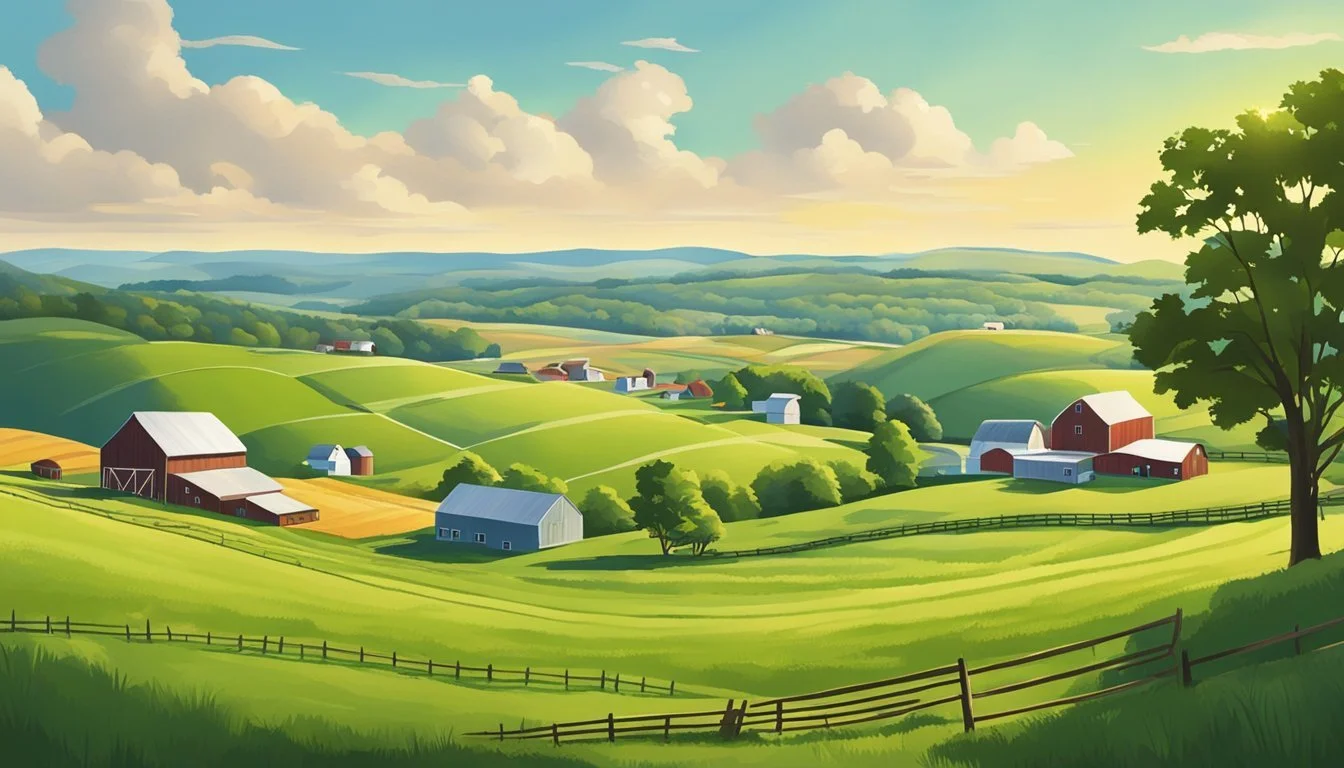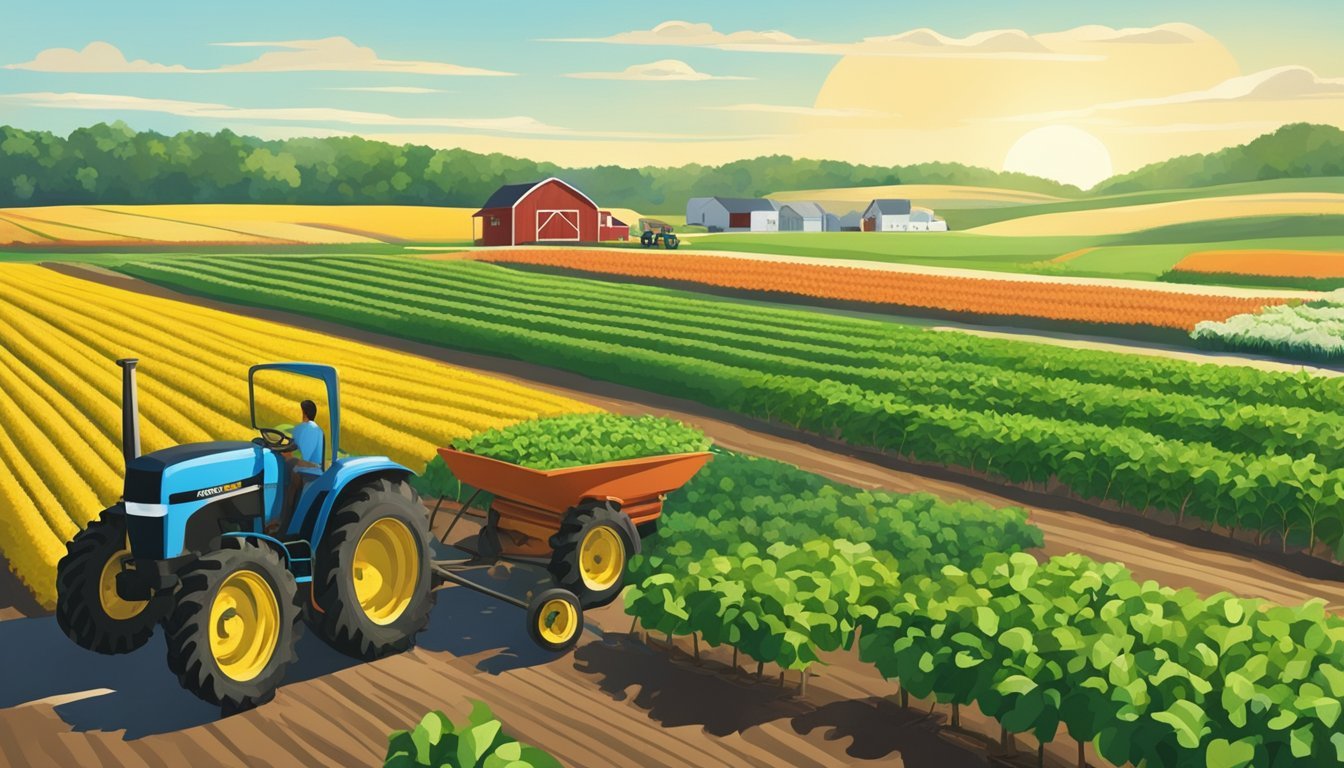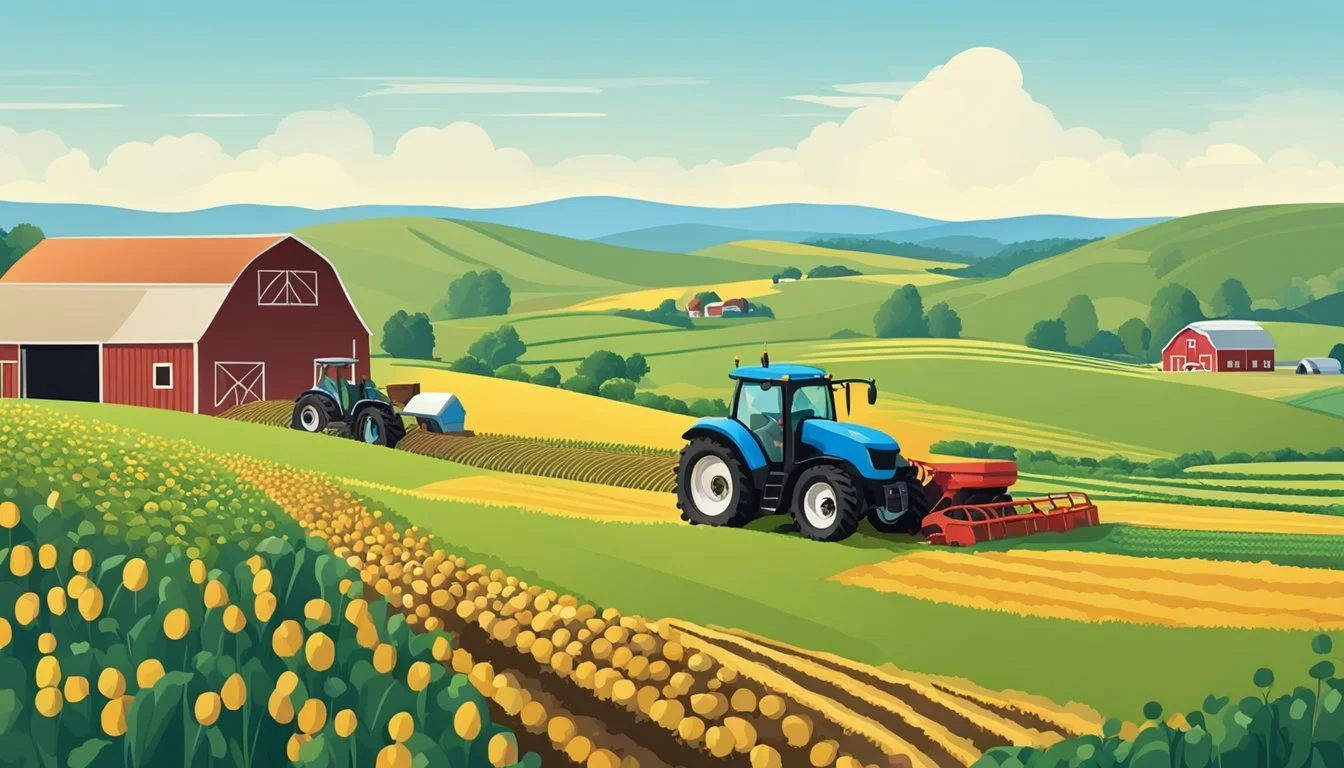Guide to Farming in Maryland
Essential Tips for Success
This Article is Part of Our State by State Farming Guide
Maryland's diverse climate and rich soil create an ideal setting for a variety of agricultural activities. Farming in Maryland is not only a vital contributor to the state's economy but also a way of life for many. With traditions deeply rooted in the past, Maryland farmers are turning to embrace both conventional and innovative agricultural practices to meet the demands of modern consumption. From the rolling hills of the Piedmont region to the flat coastal plains, the state offers a rich tapestry of landscapes, accommodating a wide range of farming operations including crop production, livestock, and dairy farming.
Navigating the intricacies of starting and maintaining a successful farm requires understanding the local regulations, climatic conditions, and market trends. The University of Maryland Extension provides resources designed to assist beginning farmers in exploring and developing their farm businesses successfully. Educational materials and personalized guidance help individuals make informed decisions about crops and farming techniques best suited for their specific locations within the state.
Addressing the needs of the agriculture industry, state authorities and educational institutions work together to compile and publish critical data on agricultural production, marketing, and income. This collaborative effort ensures that Maryland's agricultural community has access to up-to-date information, facilitating efficient and sustainable farm management. Expertise from extension educators guides farmers through the process of obtaining necessary licenses, permits, and certifications, laying the groundwork for robust and law-abiding agricultural enterprises.
Understanding Maryland's Agriculture Landscape
Maryland's agriculture is as diverse as its regions, thriving on a variety of crops and livestock, and bolstered by a rich history and dedicated farming community.
Maryland at a Glance
Maryland, with its unique geography ranging from the Atlantic coast to Appalachian mountains, offers a tapestry of farming landscapes. The state's counties each contribute distinctly to its overall agricultural output. From the Eastern Shore's extensive tillage to the central counties' mix of produce and livestock, one can observe a microcosm of American farming within its borders.
Regional Agricultural Highlights
Eastern Shore: Dominated by grain, vegetable farms, and the poultry industry, it is a cornerstone of Maryland's agricultural economy. The area's flat, fertile lands are ideal for large-scale grain production and support the robust poultry sector.
Central Maryland: Here, smaller-scale farms operate, often focusing on a diverse array of organic crops, dairy, and artisanal products catering to the demands of nearby urban populations.
Western Maryland: It is characterized by more rugged terrain, favoring pasture-based dairy and beef operations, as well as forestry-related agriculture.
Important Crops in Maryland
Maryland farmers grow a variety of crops, each critical to the state's agricultural profile:
Grains: Including corn, wheat, and soybeans, which are staples for both human consumption and as feed in the poultry and livestock industries.
Vegetables: Such as tomatoes, watermelons, and sweet corn, are significant contributors to the local and regional markets.
In summary, from the Eastern Shore to the mountainous west, Maryland supports a rich and varied agriculture industry, deeply woven into the state's economy and culture.
Starting a Farm in Maryland
Initiating a farming venture in Maryland involves understanding local agricultural practices, securing land, and meticulous business planning. Farmers have access to comprehensive resources such as the Beginning Farmer Guidebook to navigate these critical steps.
Becoming a Farmer
One embarks on farming in Maryland by first diving into reputable resources such as the Beginning Farmer Guidebook, which is crafted to assist new farmers in the region. Essential topics covered include farm strategy formulation, organic production, and a broad overview of food safety.
Land Acquisition and Management
Acquiring and managing farmland strategically is pivotal. One must consider land suitability for various farm productions, such as crops or livestock, and understand the nuances of land management to ensure sustainability and productivity.
Business Planning and Development
Robust business planning underpins successful farming operations. This includes creating a detailed business plan, exploring financial resources, and developing a sound operational strategy. Prospective Maryland farmers are encouraged to investigate local financial resources available to support agricultural enterprises.
Agricultural Education and Support
Maryland offers extensive educational resources and support networks dedicated to helping new and experienced farmers succeed. These range from university-led programs to nonprofit organizations that provide essential training and resources.
University-Led Programs
The University of Maryland Extension serves as a pivotal resource for agricultural education, providing a wealth of knowledge through workshops and the Beginning Farmer Success Project. This initiative includes guidebooks, instructional videos, and on-farm training to promote successful farming practices. They facilitate the Maryland Collaborative for Beginning Farmer Success, which is instrumental in educating and assisting new farmers in Maryland.
Workshops and Training:
Nutrient Management
Pesticide Applicator Certification
Soil Conservation Planning
Resources:
Guidebooks
Instructional Videos
On-Farm Training
Nonprofit and Organization Resources
Several regional nonprofits and agricultural organizations offer support to Maryland's agricultural community. Future Harvest-CASA is one such nonprofit that stands out by providing a network of support for sustainable agriculture and advocating for the interests of farmers across the Chesapeake region. They offer resources for new farmers, including educational events and a strong community network.
Support Offered:
Educational Events
Community Network
Advocacy
Continuing Education for Farmers
Continuous learning and development are crucial for farmers to stay abreast of the latest agricultural trends and regulations. In Maryland, experienced farmers and agricultural service providers run a variety of advanced workshops and continuing education programs. These programs are designed to support ongoing growth and sustainability in the farming sector.
Advanced Opportunities:
Nutrient Management Plans
Advanced Agricultural Techniques
Cultivating Specialty Areas
Maryland's diverse agricultural terrain allows for targeted specialty areas in farming, namely vineyards and winemaking, organic farming, and sustainable practices. These niches benefit from the state's unique climate and soil conditions, expanding Maryland’s agricultural tapestry.
Vineyards and Winemaking
Maryland wine production has a dedicated niche in agriculture with the support of the Governor's Advisory Commission on Maryland Wine and Grape Growing. The commission aids in promoting the growth of grapes suited to Maryland's climate.
Grape Growing: Maryland soil health is conducive to several grape varietals, which includes the careful selection of sites where grapes can thrive. This involves managing sunlight exposure and drainage to optimize vine health and yield.
Wineries: The state is home to a burgeoning number of small wineries, each contributing to a rich tradition of wine production. Maryland offers a variety of soil types, from sandy loam to clay, that are instrumental for different grape varieties.
Organic Farming
Organic farming in Maryland emphasizes maintaining soil health through sustainable practices, avoiding the use of synthetic pesticides and fertilizers.
Greenhouse Operations: Organic farmers often use greenhouses to extend growing seasons and protect crops from pests and weather, while still adhering to organic standards.
Certification: Adherence to organic methods requires rigorous certification, assuring consumers of the product's organic integrity.
Sustainable Practices
Maryland's agricultural sector is increasingly adopting sustainable practices to ensure long-term soil health and environmental protection.
Soil Conservation: Techniques like crop rotation, cover cropping, and reduced tillage are employed to preserve soil structure and fertility.
Environmental Impact: Sustainable practices go beyond the field, including efforts to minimize water usage and implement renewable energy sources in farming operations.
Economic Aspects of Maryland Farming
Maryland's agriculture boasts a rich diversity, serving as a substantial economic asset to the state. With a focus on market opportunities and challenges, promotion and marketing strategies, as well as available financial assistance and incentives, one gains a comprehensive understanding of the economic layers that sustain and advance farming enterprises in this region.
Market Opportunities and Challenges
Maryland farmers face a dynamic market, with diverse enterprise options ranging from traditional crops to livestock, dairy, and specialty products such as honey and wine. The state's strategic location allows for direct marketing to a dense population, boosting direct-to-consumer sales. However, farmers must navigate fluctuating demand, competitive pricing, and the pressure to adapt to sustainable practices.
Direct Marketing Growth: From 1997 to 2007, Maryland saw direct-to-consumer sales surge from $551 million to $1.2 billion.
Economic Impact: In 2000, the average net income per Maryland farm was approximately $33,000, notably surpassing that of neighboring states and the national average.
Promotion and Marketing Strategies
In Maryland, effective marketing strategies are integral for farming success. Promotion takes various forms, from engaging in local farmers' markets to utilizing online platforms for wider reach. Farmers are encouraged to refine their branding and implement innovative techniques to attract and retain a diverse consumer base.
Branding Opportunities: Leveraging Maryland's reputation for quality and variety can aid farmers in differentiating their products.
Technological Advancements: The integration of online sales and marketing can expand market access beyond traditional local economies.
Financial Assistance and Incentives
Financial resources in Maryland support new and existing agricultural businesses in their initial development and long-term sustainability. The state offers a variety of grants, loans, and tax credits to assist farmers in starting or expanding their enterprises.
Starting a Farm: The "Beginning Farmer Guidebook" provided by the University of Maryland Extension is a resource that helps new farmers access necessary financial tools.
Incentives: Tax credits and grants for practices such as environmental conservation improve the financial feasibility of implementing eco-friendly initiatives.
Natural Resources and Environmental Management
Maryland's diverse agriculture sector operates within the framework of environmental stewardship, focusing on the preservation of land and water resources, and integration of renewable energy for sustainable farming practices.
Land Preservation
Land preservation initiatives in Maryland ensure that prime farmlands are kept intact for agricultural use. Programs such as Maryland Agricultural Land Preservation Foundation (MALPF) allow for the voluntary sale of development rights by farmers to the state, effectively preventing future non-agricultural use of this land. This not only maintains the agricultural landscape but also helps in protecting natural resources crucial for farming activities.
Water and Irrigation
Responsible water management is critical for Maryland's farm sustainability. Best practices include the creation of water-efficient irrigation systems and adhering to Nutrient Management Regulations. Farmers are guided to apply the right amount of water and nutrients at optimal times to reduce run-off, protect water quality, and improve crop yields.
Tailored irrigation scheduling
Nutrient management plans
Prescribed setbacks for nutrient applications
Renewable Energy on the Farm
Maryland promotes the use of renewable energy sources on farms to increase self-sufficiency and reduce environmental footprints. Wind and solar energy installations are becoming more prevalent, providing farms with cleaner power options that also offer potential new income streams.
Examples of Renewable Installations:
Solar panels on barns and outbuildings
Wind turbines on higher elevation farm areas
Networking and Community Involvement
Effective networking and community involvement are crucial for farming success in Maryland. Farmers can benefit significantly from building relationships, engaging with agricultural organizations, and participating in local markets.
Building Relationships with Other Farmers
Farmers in Maryland have various opportunities to connect with peers. These relationships facilitate knowledge exchange, mutual support, and can lead to collaborative efforts in farm management and problem-solving. For example, the Baltimore Farmers' Market, located at the intersection of Holliday and Saratoga Streets, serves as a gathering place where farmers can meet and share experiences while selling their produce.
Engaging with Agricultural Organizations
Maryland hosts numerous agricultural organizations and nonprofits dedicated to supporting farmers. By engaging with these entities, farmers gain access to a wealth of resources, including educational materials, entrepreneurial coaching, and networking events. Organizations like the Southern Maryland Agricultural Development Commission and the University of Maryland Extension offer publications and programs that address the specific needs of Maryland farmers.
Participation in Local Markets
Participation in local markets is not only a revenue avenue but also an excellent way for farms to integrate into the community. Farmers can showcase their products to a diverse clientele, receive feedback, and create a loyal customer base. This engagement fosters a connection between consumers and the source of their food, thereby boosting the local economy and the sustainability of farms in Maryland.
Maryland's Agricultural Future
As Maryland agriculture advances, key initiatives are focusing on incorporating innovative techniques, nurturing the next generation of farmers, and engaging in effective policy and government action.
Innovation in Farming
Maryland's agricultural sector is embracing technological advancement to increase farm productivity and sustainability. Initiatives include precision agriculture to maximize crop yields while preserving resources. The University of Maryland Extension provides vital resources and modern farming education to support these innovations.
Next Generation of Farmers
The future of Maryland farming relies on the new farmers who will develop and apply advancements in the field. Programs like the Beginning Farmer Success program of the University of Maryland Extension offer guidance and training for new farmers. By exploring and refining farming techniques, these individuals will shape Maryland agriculture.
Policy and Government Involvement
Maryland's government and educational institutions are pivotal in shaping the state's agricultural policy. Collaborations between Maryland universities, government agencies, and farming organizations aim to support the agricultural community. Key contacts in this network include:
Maryland Departments: Work with farmers to provide necessary services.
Maryland Cooperative Extension: Offers educational support to farmers.
Task Forces and Advisory Boards: Address ongoing agricultural challenges and opportunities.
Engagement with these entities helps ensure that Maryland’s agricultural policies are forward-thinking and beneficial for the industry’s long-term growth.









